Business and the Business Environment Report: Sainsbury's Analysis
VerifiedAdded on 2021/01/02
|16
|4777
|434
Report
AI Summary
This report provides a comprehensive analysis of the business environment, encompassing various organizational types such as public, private, and voluntary organizations, along with their legal structures and scopes. It delves into the interrelationships between different organizational functions like HR, marketing, technology, and R&D, and how these functions contribute to the overall organizational objectives and structure. The report also examines the impact of the macro environment on business operations, followed by a detailed SWOT analysis of Sainsbury's, highlighting its internal strengths and weaknesses in relation to external macro factors. The report concludes with a discussion of the interrelation between the company's strengths and weaknesses and the external macro factors.
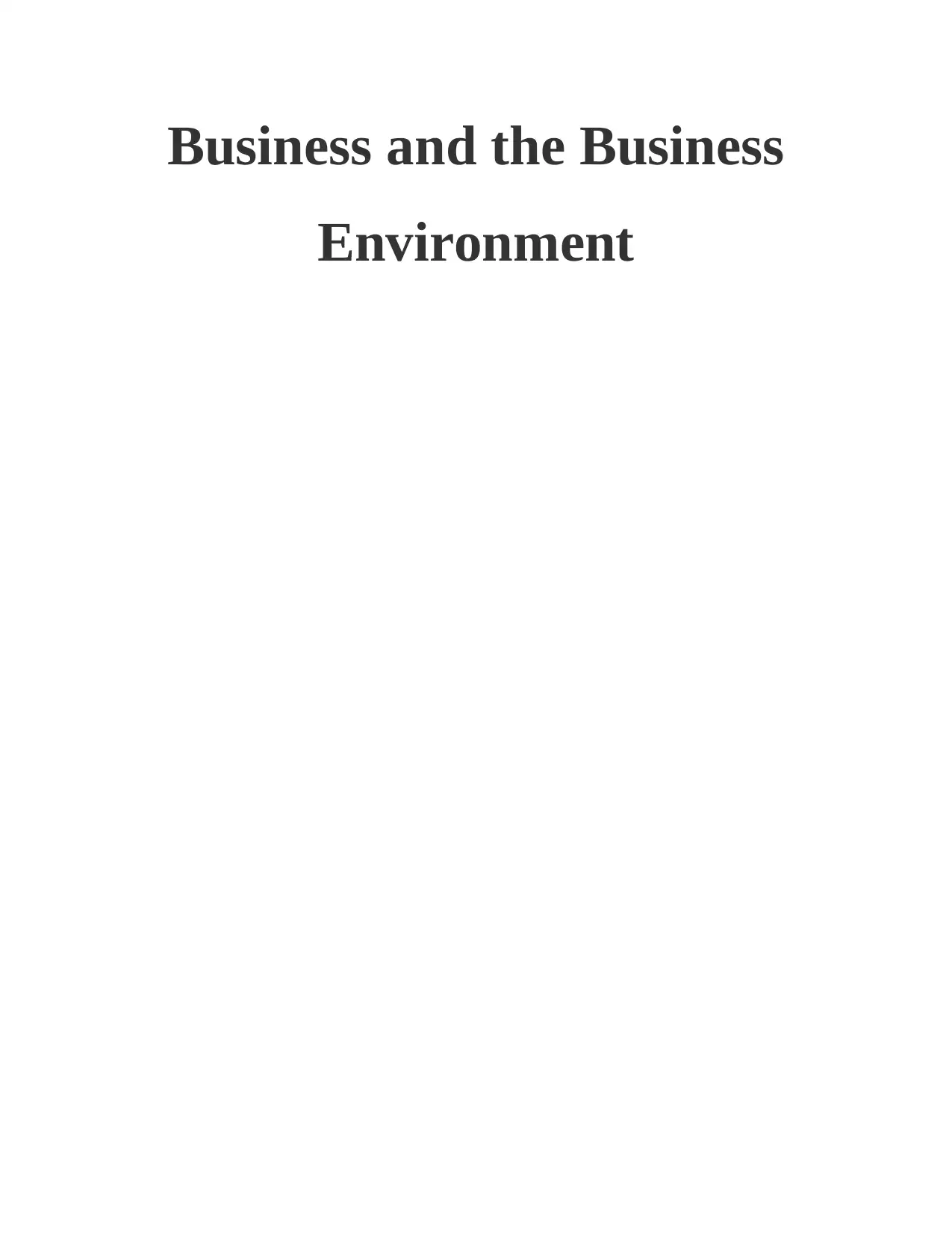
Business and the Business
Environment
Environment
Paraphrase This Document
Need a fresh take? Get an instant paraphrase of this document with our AI Paraphraser
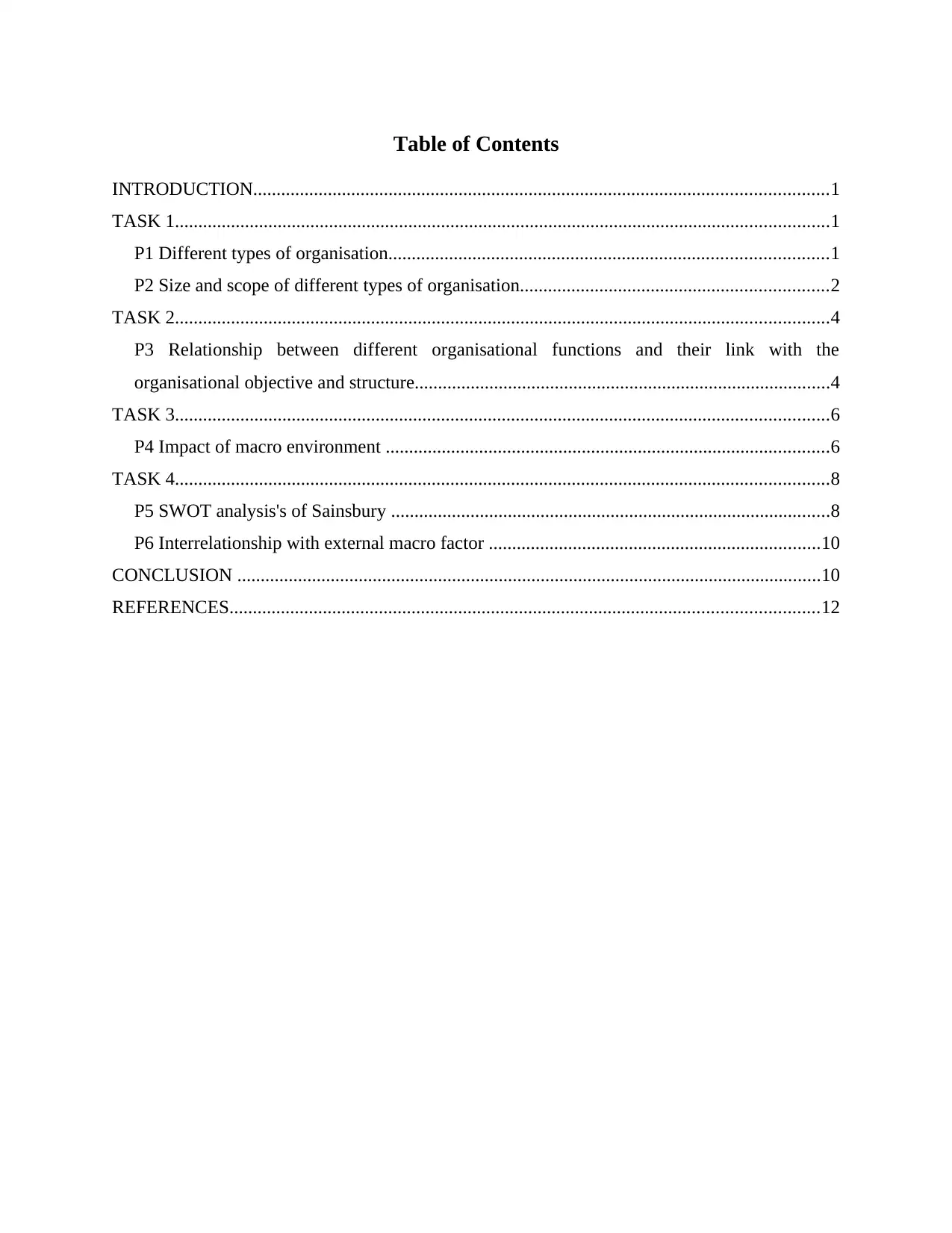
Table of Contents
INTRODUCTION...........................................................................................................................1
TASK 1............................................................................................................................................1
P1 Different types of organisation..............................................................................................1
P2 Size and scope of different types of organisation..................................................................2
TASK 2............................................................................................................................................4
P3 Relationship between different organisational functions and their link with the
organisational objective and structure.........................................................................................4
TASK 3............................................................................................................................................6
P4 Impact of macro environment ...............................................................................................6
TASK 4............................................................................................................................................8
P5 SWOT analysis's of Sainsbury ..............................................................................................8
P6 Interrelationship with external macro factor .......................................................................10
CONCLUSION .............................................................................................................................10
REFERENCES..............................................................................................................................12
INTRODUCTION...........................................................................................................................1
TASK 1............................................................................................................................................1
P1 Different types of organisation..............................................................................................1
P2 Size and scope of different types of organisation..................................................................2
TASK 2............................................................................................................................................4
P3 Relationship between different organisational functions and their link with the
organisational objective and structure.........................................................................................4
TASK 3............................................................................................................................................6
P4 Impact of macro environment ...............................................................................................6
TASK 4............................................................................................................................................8
P5 SWOT analysis's of Sainsbury ..............................................................................................8
P6 Interrelationship with external macro factor .......................................................................10
CONCLUSION .............................................................................................................................10
REFERENCES..............................................................................................................................12

⊘ This is a preview!⊘
Do you want full access?
Subscribe today to unlock all pages.

Trusted by 1+ million students worldwide
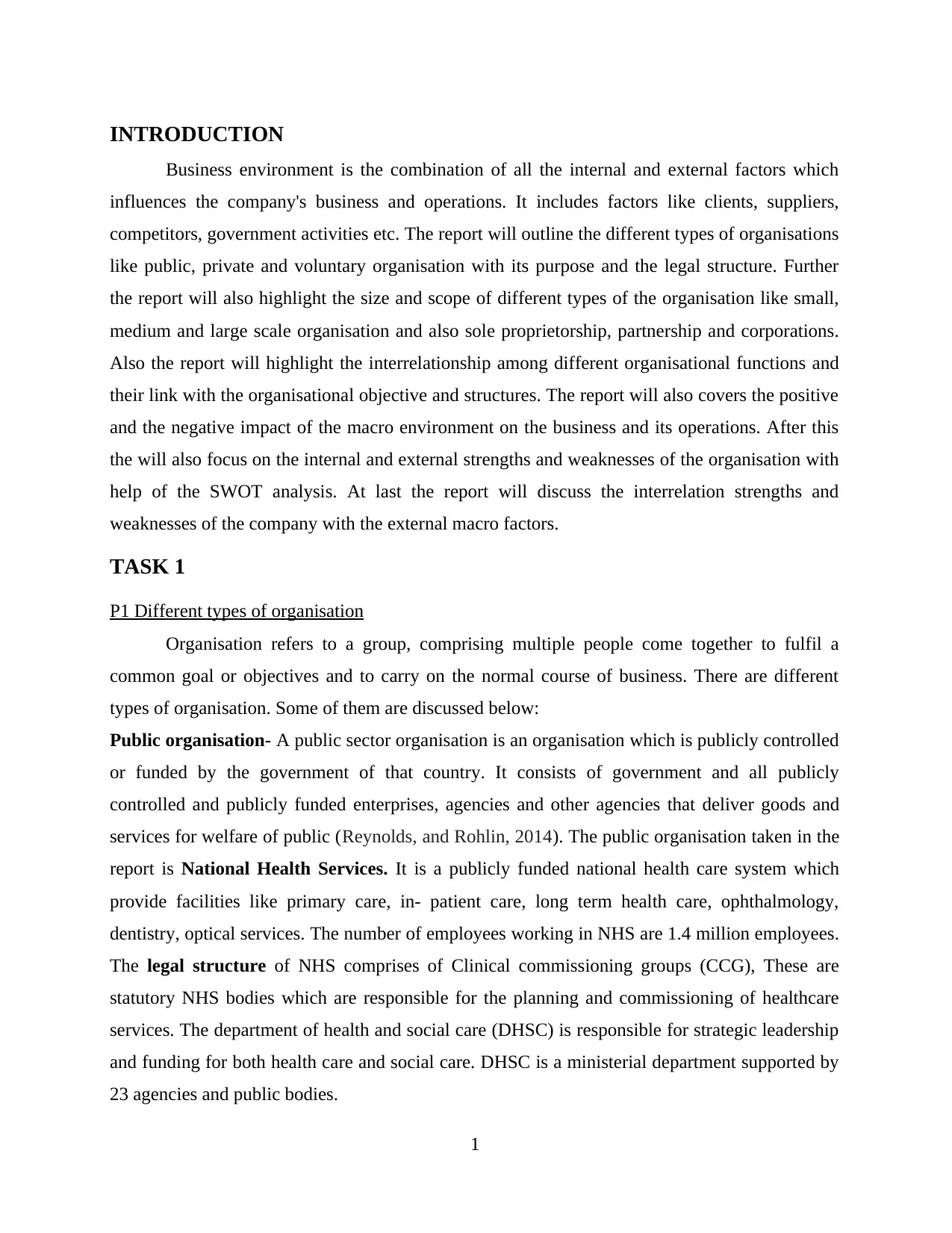
INTRODUCTION
Business environment is the combination of all the internal and external factors which
influences the company's business and operations. It includes factors like clients, suppliers,
competitors, government activities etc. The report will outline the different types of organisations
like public, private and voluntary organisation with its purpose and the legal structure. Further
the report will also highlight the size and scope of different types of the organisation like small,
medium and large scale organisation and also sole proprietorship, partnership and corporations.
Also the report will highlight the interrelationship among different organisational functions and
their link with the organisational objective and structures. The report will also covers the positive
and the negative impact of the macro environment on the business and its operations. After this
the will also focus on the internal and external strengths and weaknesses of the organisation with
help of the SWOT analysis. At last the report will discuss the interrelation strengths and
weaknesses of the company with the external macro factors.
TASK 1
P1 Different types of organisation
Organisation refers to a group, comprising multiple people come together to fulfil a
common goal or objectives and to carry on the normal course of business. There are different
types of organisation. Some of them are discussed below:
Public organisation- A public sector organisation is an organisation which is publicly controlled
or funded by the government of that country. It consists of government and all publicly
controlled and publicly funded enterprises, agencies and other agencies that deliver goods and
services for welfare of public (Reynolds, and Rohlin, 2014). The public organisation taken in the
report is National Health Services. It is a publicly funded national health care system which
provide facilities like primary care, in- patient care, long term health care, ophthalmology,
dentistry, optical services. The number of employees working in NHS are 1.4 million employees.
The legal structure of NHS comprises of Clinical commissioning groups (CCG), These are
statutory NHS bodies which are responsible for the planning and commissioning of healthcare
services. The department of health and social care (DHSC) is responsible for strategic leadership
and funding for both health care and social care. DHSC is a ministerial department supported by
23 agencies and public bodies.
1
Business environment is the combination of all the internal and external factors which
influences the company's business and operations. It includes factors like clients, suppliers,
competitors, government activities etc. The report will outline the different types of organisations
like public, private and voluntary organisation with its purpose and the legal structure. Further
the report will also highlight the size and scope of different types of the organisation like small,
medium and large scale organisation and also sole proprietorship, partnership and corporations.
Also the report will highlight the interrelationship among different organisational functions and
their link with the organisational objective and structures. The report will also covers the positive
and the negative impact of the macro environment on the business and its operations. After this
the will also focus on the internal and external strengths and weaknesses of the organisation with
help of the SWOT analysis. At last the report will discuss the interrelation strengths and
weaknesses of the company with the external macro factors.
TASK 1
P1 Different types of organisation
Organisation refers to a group, comprising multiple people come together to fulfil a
common goal or objectives and to carry on the normal course of business. There are different
types of organisation. Some of them are discussed below:
Public organisation- A public sector organisation is an organisation which is publicly controlled
or funded by the government of that country. It consists of government and all publicly
controlled and publicly funded enterprises, agencies and other agencies that deliver goods and
services for welfare of public (Reynolds, and Rohlin, 2014). The public organisation taken in the
report is National Health Services. It is a publicly funded national health care system which
provide facilities like primary care, in- patient care, long term health care, ophthalmology,
dentistry, optical services. The number of employees working in NHS are 1.4 million employees.
The legal structure of NHS comprises of Clinical commissioning groups (CCG), These are
statutory NHS bodies which are responsible for the planning and commissioning of healthcare
services. The department of health and social care (DHSC) is responsible for strategic leadership
and funding for both health care and social care. DHSC is a ministerial department supported by
23 agencies and public bodies.
1
Paraphrase This Document
Need a fresh take? Get an instant paraphrase of this document with our AI Paraphraser
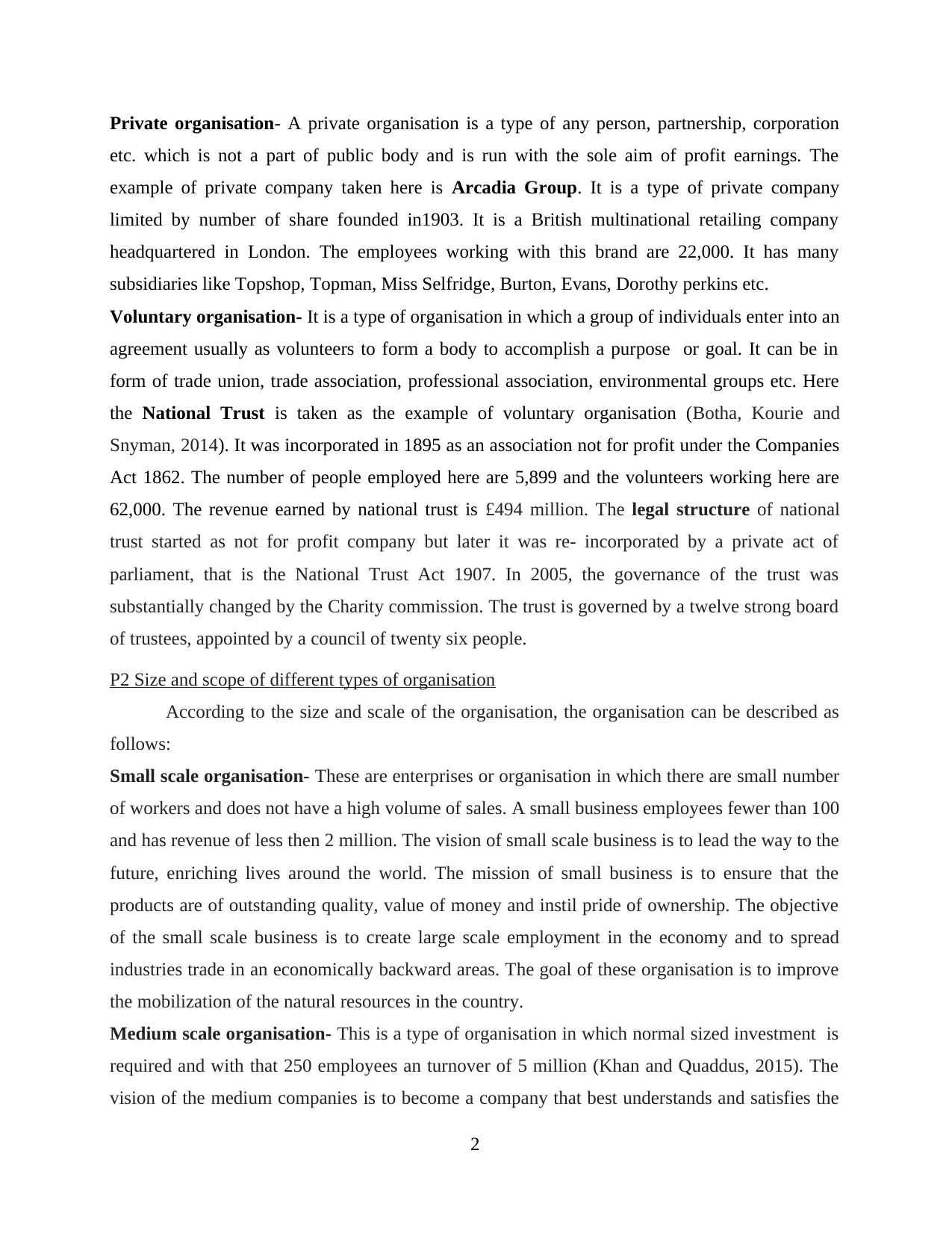
Private organisation- A private organisation is a type of any person, partnership, corporation
etc. which is not a part of public body and is run with the sole aim of profit earnings. The
example of private company taken here is Arcadia Group. It is a type of private company
limited by number of share founded in1903. It is a British multinational retailing company
headquartered in London. The employees working with this brand are 22,000. It has many
subsidiaries like Topshop, Topman, Miss Selfridge, Burton, Evans, Dorothy perkins etc.
Voluntary organisation- It is a type of organisation in which a group of individuals enter into an
agreement usually as volunteers to form a body to accomplish a purpose or goal. It can be in
form of trade union, trade association, professional association, environmental groups etc. Here
the National Trust is taken as the example of voluntary organisation (Botha, Kourie and
Snyman, 2014). It was incorporated in 1895 as an association not for profit under the Companies
Act 1862. The number of people employed here are 5,899 and the volunteers working here are
62,000. The revenue earned by national trust is £494 million. The legal structure of national
trust started as not for profit company but later it was re- incorporated by a private act of
parliament, that is the National Trust Act 1907. In 2005, the governance of the trust was
substantially changed by the Charity commission. The trust is governed by a twelve strong board
of trustees, appointed by a council of twenty six people.
P2 Size and scope of different types of organisation
According to the size and scale of the organisation, the organisation can be described as
follows:
Small scale organisation- These are enterprises or organisation in which there are small number
of workers and does not have a high volume of sales. A small business employees fewer than 100
and has revenue of less then 2 million. The vision of small scale business is to lead the way to the
future, enriching lives around the world. The mission of small business is to ensure that the
products are of outstanding quality, value of money and instil pride of ownership. The objective
of the small scale business is to create large scale employment in the economy and to spread
industries trade in an economically backward areas. The goal of these organisation is to improve
the mobilization of the natural resources in the country.
Medium scale organisation- This is a type of organisation in which normal sized investment is
required and with that 250 employees an turnover of 5 million (Khan and Quaddus, 2015). The
vision of the medium companies is to become a company that best understands and satisfies the
2
etc. which is not a part of public body and is run with the sole aim of profit earnings. The
example of private company taken here is Arcadia Group. It is a type of private company
limited by number of share founded in1903. It is a British multinational retailing company
headquartered in London. The employees working with this brand are 22,000. It has many
subsidiaries like Topshop, Topman, Miss Selfridge, Burton, Evans, Dorothy perkins etc.
Voluntary organisation- It is a type of organisation in which a group of individuals enter into an
agreement usually as volunteers to form a body to accomplish a purpose or goal. It can be in
form of trade union, trade association, professional association, environmental groups etc. Here
the National Trust is taken as the example of voluntary organisation (Botha, Kourie and
Snyman, 2014). It was incorporated in 1895 as an association not for profit under the Companies
Act 1862. The number of people employed here are 5,899 and the volunteers working here are
62,000. The revenue earned by national trust is £494 million. The legal structure of national
trust started as not for profit company but later it was re- incorporated by a private act of
parliament, that is the National Trust Act 1907. In 2005, the governance of the trust was
substantially changed by the Charity commission. The trust is governed by a twelve strong board
of trustees, appointed by a council of twenty six people.
P2 Size and scope of different types of organisation
According to the size and scale of the organisation, the organisation can be described as
follows:
Small scale organisation- These are enterprises or organisation in which there are small number
of workers and does not have a high volume of sales. A small business employees fewer than 100
and has revenue of less then 2 million. The vision of small scale business is to lead the way to the
future, enriching lives around the world. The mission of small business is to ensure that the
products are of outstanding quality, value of money and instil pride of ownership. The objective
of the small scale business is to create large scale employment in the economy and to spread
industries trade in an economically backward areas. The goal of these organisation is to improve
the mobilization of the natural resources in the country.
Medium scale organisation- This is a type of organisation in which normal sized investment is
required and with that 250 employees an turnover of 5 million (Khan and Quaddus, 2015). The
vision of the medium companies is to become a company that best understands and satisfies the
2
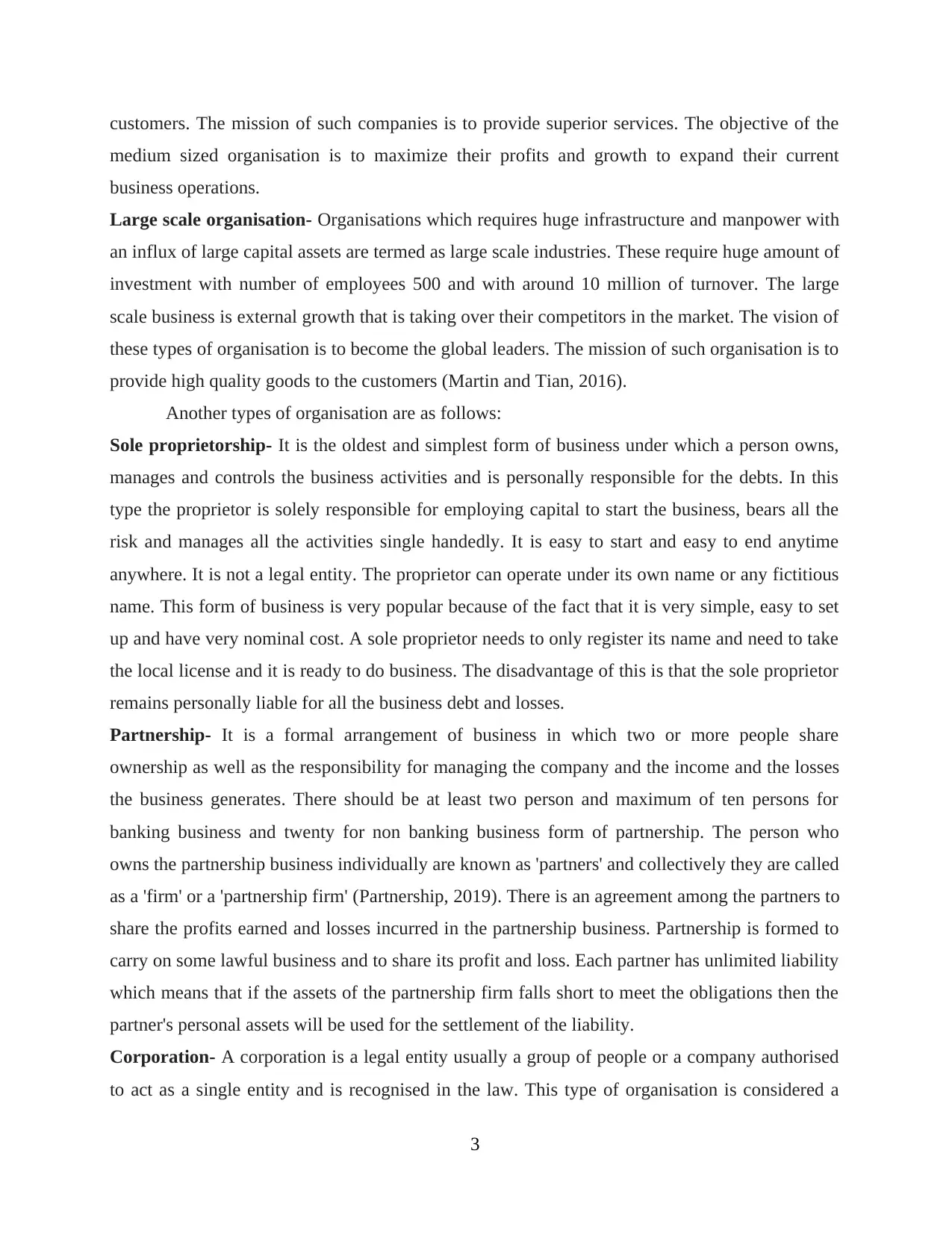
customers. The mission of such companies is to provide superior services. The objective of the
medium sized organisation is to maximize their profits and growth to expand their current
business operations.
Large scale organisation- Organisations which requires huge infrastructure and manpower with
an influx of large capital assets are termed as large scale industries. These require huge amount of
investment with number of employees 500 and with around 10 million of turnover. The large
scale business is external growth that is taking over their competitors in the market. The vision of
these types of organisation is to become the global leaders. The mission of such organisation is to
provide high quality goods to the customers (Martin and Tian, 2016).
Another types of organisation are as follows:
Sole proprietorship- It is the oldest and simplest form of business under which a person owns,
manages and controls the business activities and is personally responsible for the debts. In this
type the proprietor is solely responsible for employing capital to start the business, bears all the
risk and manages all the activities single handedly. It is easy to start and easy to end anytime
anywhere. It is not a legal entity. The proprietor can operate under its own name or any fictitious
name. This form of business is very popular because of the fact that it is very simple, easy to set
up and have very nominal cost. A sole proprietor needs to only register its name and need to take
the local license and it is ready to do business. The disadvantage of this is that the sole proprietor
remains personally liable for all the business debt and losses.
Partnership- It is a formal arrangement of business in which two or more people share
ownership as well as the responsibility for managing the company and the income and the losses
the business generates. There should be at least two person and maximum of ten persons for
banking business and twenty for non banking business form of partnership. The person who
owns the partnership business individually are known as 'partners' and collectively they are called
as a 'firm' or a 'partnership firm' (Partnership, 2019). There is an agreement among the partners to
share the profits earned and losses incurred in the partnership business. Partnership is formed to
carry on some lawful business and to share its profit and loss. Each partner has unlimited liability
which means that if the assets of the partnership firm falls short to meet the obligations then the
partner's personal assets will be used for the settlement of the liability.
Corporation- A corporation is a legal entity usually a group of people or a company authorised
to act as a single entity and is recognised in the law. This type of organisation is considered a
3
medium sized organisation is to maximize their profits and growth to expand their current
business operations.
Large scale organisation- Organisations which requires huge infrastructure and manpower with
an influx of large capital assets are termed as large scale industries. These require huge amount of
investment with number of employees 500 and with around 10 million of turnover. The large
scale business is external growth that is taking over their competitors in the market. The vision of
these types of organisation is to become the global leaders. The mission of such organisation is to
provide high quality goods to the customers (Martin and Tian, 2016).
Another types of organisation are as follows:
Sole proprietorship- It is the oldest and simplest form of business under which a person owns,
manages and controls the business activities and is personally responsible for the debts. In this
type the proprietor is solely responsible for employing capital to start the business, bears all the
risk and manages all the activities single handedly. It is easy to start and easy to end anytime
anywhere. It is not a legal entity. The proprietor can operate under its own name or any fictitious
name. This form of business is very popular because of the fact that it is very simple, easy to set
up and have very nominal cost. A sole proprietor needs to only register its name and need to take
the local license and it is ready to do business. The disadvantage of this is that the sole proprietor
remains personally liable for all the business debt and losses.
Partnership- It is a formal arrangement of business in which two or more people share
ownership as well as the responsibility for managing the company and the income and the losses
the business generates. There should be at least two person and maximum of ten persons for
banking business and twenty for non banking business form of partnership. The person who
owns the partnership business individually are known as 'partners' and collectively they are called
as a 'firm' or a 'partnership firm' (Partnership, 2019). There is an agreement among the partners to
share the profits earned and losses incurred in the partnership business. Partnership is formed to
carry on some lawful business and to share its profit and loss. Each partner has unlimited liability
which means that if the assets of the partnership firm falls short to meet the obligations then the
partner's personal assets will be used for the settlement of the liability.
Corporation- A corporation is a legal entity usually a group of people or a company authorised
to act as a single entity and is recognised in the law. This type of organisation is considered a
3
⊘ This is a preview!⊘
Do you want full access?
Subscribe today to unlock all pages.

Trusted by 1+ million students worldwide
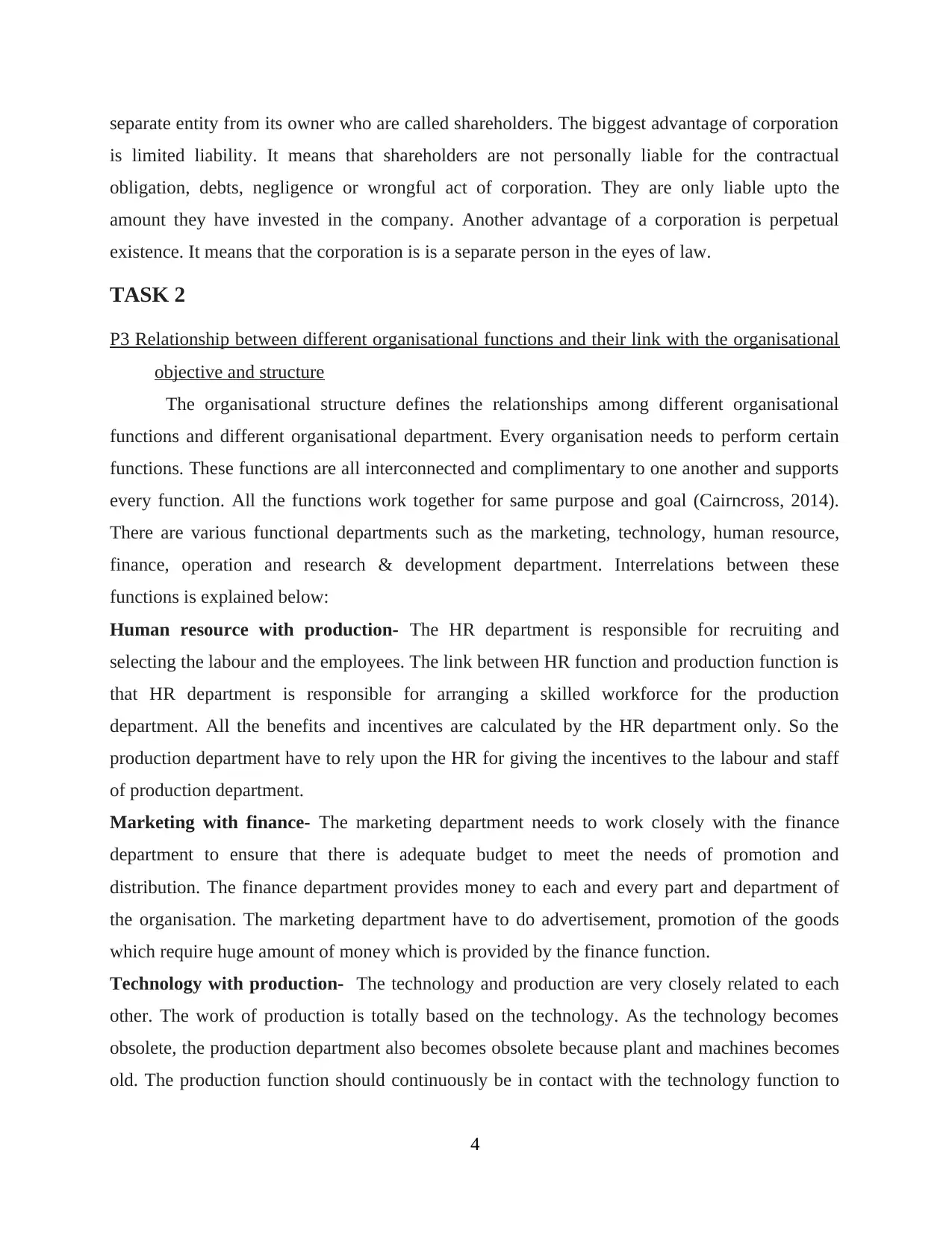
separate entity from its owner who are called shareholders. The biggest advantage of corporation
is limited liability. It means that shareholders are not personally liable for the contractual
obligation, debts, negligence or wrongful act of corporation. They are only liable upto the
amount they have invested in the company. Another advantage of a corporation is perpetual
existence. It means that the corporation is is a separate person in the eyes of law.
TASK 2
P3 Relationship between different organisational functions and their link with the organisational
objective and structure
The organisational structure defines the relationships among different organisational
functions and different organisational department. Every organisation needs to perform certain
functions. These functions are all interconnected and complimentary to one another and supports
every function. All the functions work together for same purpose and goal (Cairncross, 2014).
There are various functional departments such as the marketing, technology, human resource,
finance, operation and research & development department. Interrelations between these
functions is explained below:
Human resource with production- The HR department is responsible for recruiting and
selecting the labour and the employees. The link between HR function and production function is
that HR department is responsible for arranging a skilled workforce for the production
department. All the benefits and incentives are calculated by the HR department only. So the
production department have to rely upon the HR for giving the incentives to the labour and staff
of production department.
Marketing with finance- The marketing department needs to work closely with the finance
department to ensure that there is adequate budget to meet the needs of promotion and
distribution. The finance department provides money to each and every part and department of
the organisation. The marketing department have to do advertisement, promotion of the goods
which require huge amount of money which is provided by the finance function.
Technology with production- The technology and production are very closely related to each
other. The work of production is totally based on the technology. As the technology becomes
obsolete, the production department also becomes obsolete because plant and machines becomes
old. The production function should continuously be in contact with the technology function to
4
is limited liability. It means that shareholders are not personally liable for the contractual
obligation, debts, negligence or wrongful act of corporation. They are only liable upto the
amount they have invested in the company. Another advantage of a corporation is perpetual
existence. It means that the corporation is is a separate person in the eyes of law.
TASK 2
P3 Relationship between different organisational functions and their link with the organisational
objective and structure
The organisational structure defines the relationships among different organisational
functions and different organisational department. Every organisation needs to perform certain
functions. These functions are all interconnected and complimentary to one another and supports
every function. All the functions work together for same purpose and goal (Cairncross, 2014).
There are various functional departments such as the marketing, technology, human resource,
finance, operation and research & development department. Interrelations between these
functions is explained below:
Human resource with production- The HR department is responsible for recruiting and
selecting the labour and the employees. The link between HR function and production function is
that HR department is responsible for arranging a skilled workforce for the production
department. All the benefits and incentives are calculated by the HR department only. So the
production department have to rely upon the HR for giving the incentives to the labour and staff
of production department.
Marketing with finance- The marketing department needs to work closely with the finance
department to ensure that there is adequate budget to meet the needs of promotion and
distribution. The finance department provides money to each and every part and department of
the organisation. The marketing department have to do advertisement, promotion of the goods
which require huge amount of money which is provided by the finance function.
Technology with production- The technology and production are very closely related to each
other. The work of production is totally based on the technology. As the technology becomes
obsolete, the production department also becomes obsolete because plant and machines becomes
old. The production function should continuously be in contact with the technology function to
4
Paraphrase This Document
Need a fresh take? Get an instant paraphrase of this document with our AI Paraphraser
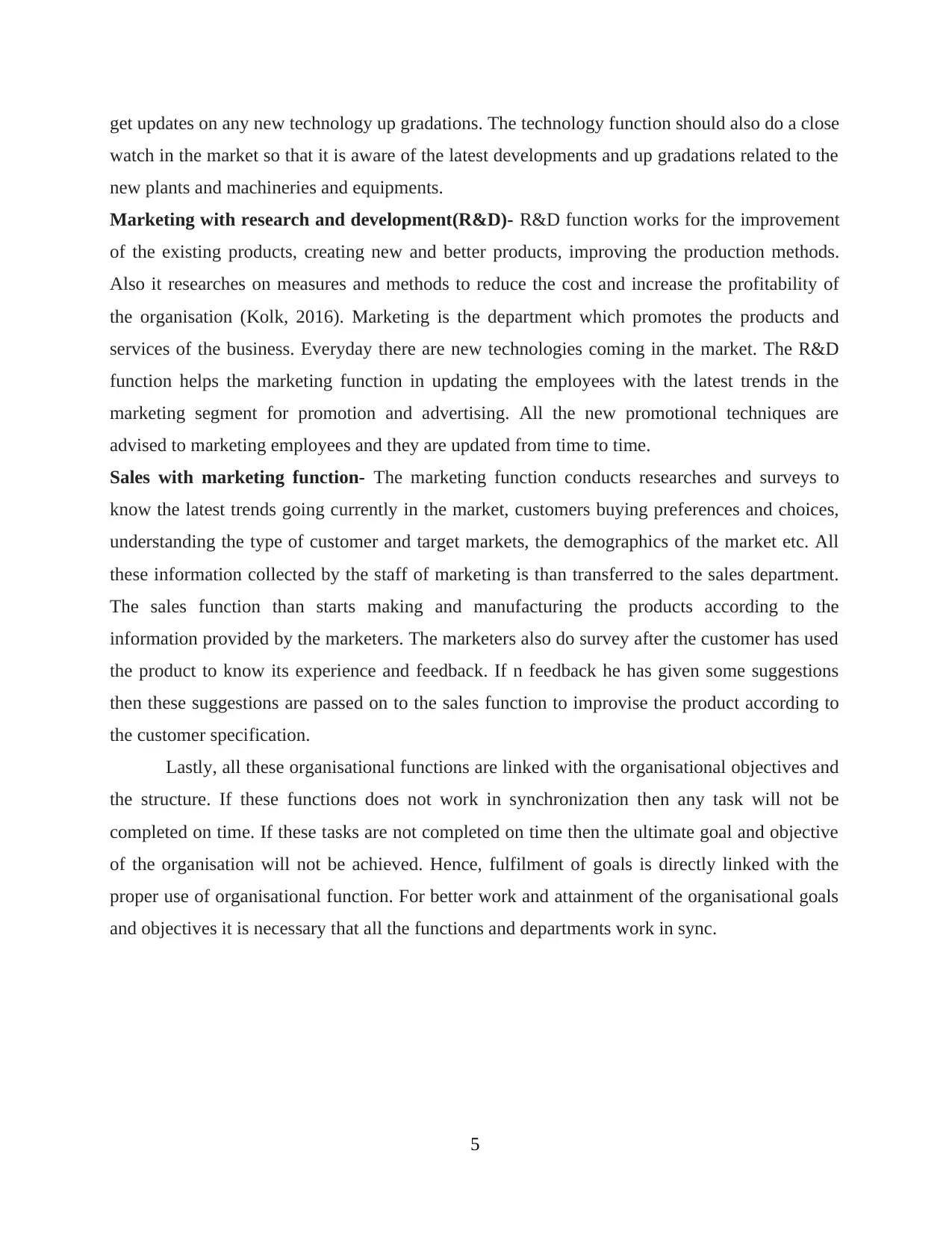
get updates on any new technology up gradations. The technology function should also do a close
watch in the market so that it is aware of the latest developments and up gradations related to the
new plants and machineries and equipments.
Marketing with research and development(R&D)- R&D function works for the improvement
of the existing products, creating new and better products, improving the production methods.
Also it researches on measures and methods to reduce the cost and increase the profitability of
the organisation (Kolk, 2016). Marketing is the department which promotes the products and
services of the business. Everyday there are new technologies coming in the market. The R&D
function helps the marketing function in updating the employees with the latest trends in the
marketing segment for promotion and advertising. All the new promotional techniques are
advised to marketing employees and they are updated from time to time.
Sales with marketing function- The marketing function conducts researches and surveys to
know the latest trends going currently in the market, customers buying preferences and choices,
understanding the type of customer and target markets, the demographics of the market etc. All
these information collected by the staff of marketing is than transferred to the sales department.
The sales function than starts making and manufacturing the products according to the
information provided by the marketers. The marketers also do survey after the customer has used
the product to know its experience and feedback. If n feedback he has given some suggestions
then these suggestions are passed on to the sales function to improvise the product according to
the customer specification.
Lastly, all these organisational functions are linked with the organisational objectives and
the structure. If these functions does not work in synchronization then any task will not be
completed on time. If these tasks are not completed on time then the ultimate goal and objective
of the organisation will not be achieved. Hence, fulfilment of goals is directly linked with the
proper use of organisational function. For better work and attainment of the organisational goals
and objectives it is necessary that all the functions and departments work in sync.
5
watch in the market so that it is aware of the latest developments and up gradations related to the
new plants and machineries and equipments.
Marketing with research and development(R&D)- R&D function works for the improvement
of the existing products, creating new and better products, improving the production methods.
Also it researches on measures and methods to reduce the cost and increase the profitability of
the organisation (Kolk, 2016). Marketing is the department which promotes the products and
services of the business. Everyday there are new technologies coming in the market. The R&D
function helps the marketing function in updating the employees with the latest trends in the
marketing segment for promotion and advertising. All the new promotional techniques are
advised to marketing employees and they are updated from time to time.
Sales with marketing function- The marketing function conducts researches and surveys to
know the latest trends going currently in the market, customers buying preferences and choices,
understanding the type of customer and target markets, the demographics of the market etc. All
these information collected by the staff of marketing is than transferred to the sales department.
The sales function than starts making and manufacturing the products according to the
information provided by the marketers. The marketers also do survey after the customer has used
the product to know its experience and feedback. If n feedback he has given some suggestions
then these suggestions are passed on to the sales function to improvise the product according to
the customer specification.
Lastly, all these organisational functions are linked with the organisational objectives and
the structure. If these functions does not work in synchronization then any task will not be
completed on time. If these tasks are not completed on time then the ultimate goal and objective
of the organisation will not be achieved. Hence, fulfilment of goals is directly linked with the
proper use of organisational function. For better work and attainment of the organisational goals
and objectives it is necessary that all the functions and departments work in sync.
5
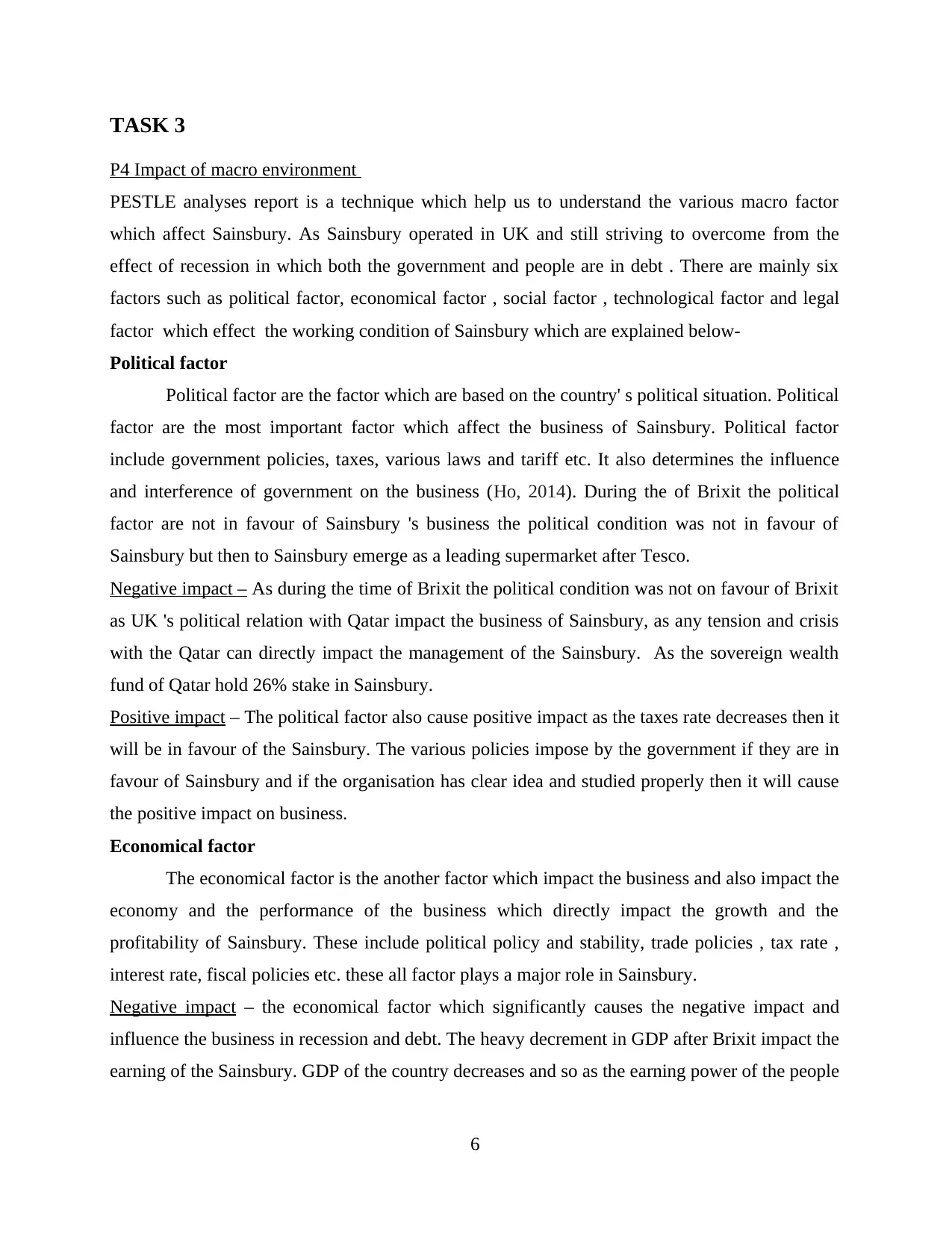
TASK 3
P4 Impact of macro environment
PESTLE analyses report is a technique which help us to understand the various macro factor
which affect Sainsbury. As Sainsbury operated in UK and still striving to overcome from the
effect of recession in which both the government and people are in debt . There are mainly six
factors such as political factor, economical factor , social factor , technological factor and legal
factor which effect the working condition of Sainsbury which are explained below-
Political factor
Political factor are the factor which are based on the country' s political situation. Political
factor are the most important factor which affect the business of Sainsbury. Political factor
include government policies, taxes, various laws and tariff etc. It also determines the influence
and interference of government on the business (Ho, 2014). During the of Brixit the political
factor are not in favour of Sainsbury 's business the political condition was not in favour of
Sainsbury but then to Sainsbury emerge as a leading supermarket after Tesco.
Negative impact – As during the time of Brixit the political condition was not on favour of Brixit
as UK 's political relation with Qatar impact the business of Sainsbury, as any tension and crisis
with the Qatar can directly impact the management of the Sainsbury. As the sovereign wealth
fund of Qatar hold 26% stake in Sainsbury.
Positive impact – The political factor also cause positive impact as the taxes rate decreases then it
will be in favour of the Sainsbury. The various policies impose by the government if they are in
favour of Sainsbury and if the organisation has clear idea and studied properly then it will cause
the positive impact on business.
Economical factor
The economical factor is the another factor which impact the business and also impact the
economy and the performance of the business which directly impact the growth and the
profitability of Sainsbury. These include political policy and stability, trade policies , tax rate ,
interest rate, fiscal policies etc. these all factor plays a major role in Sainsbury.
Negative impact – the economical factor which significantly causes the negative impact and
influence the business in recession and debt. The heavy decrement in GDP after Brixit impact the
earning of the Sainsbury. GDP of the country decreases and so as the earning power of the people
6
P4 Impact of macro environment
PESTLE analyses report is a technique which help us to understand the various macro factor
which affect Sainsbury. As Sainsbury operated in UK and still striving to overcome from the
effect of recession in which both the government and people are in debt . There are mainly six
factors such as political factor, economical factor , social factor , technological factor and legal
factor which effect the working condition of Sainsbury which are explained below-
Political factor
Political factor are the factor which are based on the country' s political situation. Political
factor are the most important factor which affect the business of Sainsbury. Political factor
include government policies, taxes, various laws and tariff etc. It also determines the influence
and interference of government on the business (Ho, 2014). During the of Brixit the political
factor are not in favour of Sainsbury 's business the political condition was not in favour of
Sainsbury but then to Sainsbury emerge as a leading supermarket after Tesco.
Negative impact – As during the time of Brixit the political condition was not on favour of Brixit
as UK 's political relation with Qatar impact the business of Sainsbury, as any tension and crisis
with the Qatar can directly impact the management of the Sainsbury. As the sovereign wealth
fund of Qatar hold 26% stake in Sainsbury.
Positive impact – The political factor also cause positive impact as the taxes rate decreases then it
will be in favour of the Sainsbury. The various policies impose by the government if they are in
favour of Sainsbury and if the organisation has clear idea and studied properly then it will cause
the positive impact on business.
Economical factor
The economical factor is the another factor which impact the business and also impact the
economy and the performance of the business which directly impact the growth and the
profitability of Sainsbury. These include political policy and stability, trade policies , tax rate ,
interest rate, fiscal policies etc. these all factor plays a major role in Sainsbury.
Negative impact – the economical factor which significantly causes the negative impact and
influence the business in recession and debt. The heavy decrement in GDP after Brixit impact the
earning of the Sainsbury. GDP of the country decreases and so as the earning power of the people
6
⊘ This is a preview!⊘
Do you want full access?
Subscribe today to unlock all pages.

Trusted by 1+ million students worldwide
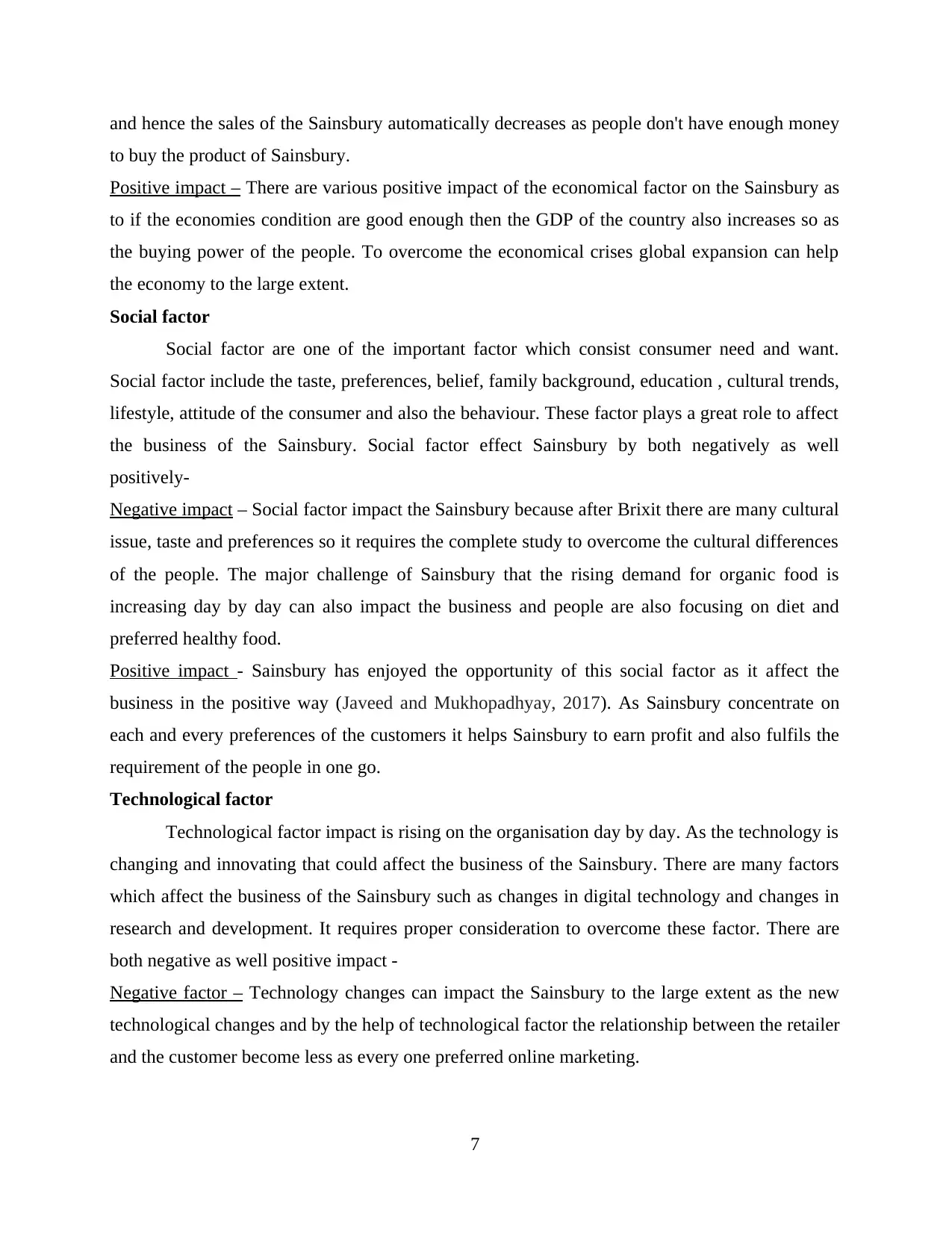
and hence the sales of the Sainsbury automatically decreases as people don't have enough money
to buy the product of Sainsbury.
Positive impact – There are various positive impact of the economical factor on the Sainsbury as
to if the economies condition are good enough then the GDP of the country also increases so as
the buying power of the people. To overcome the economical crises global expansion can help
the economy to the large extent.
Social factor
Social factor are one of the important factor which consist consumer need and want.
Social factor include the taste, preferences, belief, family background, education , cultural trends,
lifestyle, attitude of the consumer and also the behaviour. These factor plays a great role to affect
the business of the Sainsbury. Social factor effect Sainsbury by both negatively as well
positively-
Negative impact – Social factor impact the Sainsbury because after Brixit there are many cultural
issue, taste and preferences so it requires the complete study to overcome the cultural differences
of the people. The major challenge of Sainsbury that the rising demand for organic food is
increasing day by day can also impact the business and people are also focusing on diet and
preferred healthy food.
Positive impact - Sainsbury has enjoyed the opportunity of this social factor as it affect the
business in the positive way (Javeed and Mukhopadhyay, 2017). As Sainsbury concentrate on
each and every preferences of the customers it helps Sainsbury to earn profit and also fulfils the
requirement of the people in one go.
Technological factor
Technological factor impact is rising on the organisation day by day. As the technology is
changing and innovating that could affect the business of the Sainsbury. There are many factors
which affect the business of the Sainsbury such as changes in digital technology and changes in
research and development. It requires proper consideration to overcome these factor. There are
both negative as well positive impact -
Negative factor – Technology changes can impact the Sainsbury to the large extent as the new
technological changes and by the help of technological factor the relationship between the retailer
and the customer become less as every one preferred online marketing.
7
to buy the product of Sainsbury.
Positive impact – There are various positive impact of the economical factor on the Sainsbury as
to if the economies condition are good enough then the GDP of the country also increases so as
the buying power of the people. To overcome the economical crises global expansion can help
the economy to the large extent.
Social factor
Social factor are one of the important factor which consist consumer need and want.
Social factor include the taste, preferences, belief, family background, education , cultural trends,
lifestyle, attitude of the consumer and also the behaviour. These factor plays a great role to affect
the business of the Sainsbury. Social factor effect Sainsbury by both negatively as well
positively-
Negative impact – Social factor impact the Sainsbury because after Brixit there are many cultural
issue, taste and preferences so it requires the complete study to overcome the cultural differences
of the people. The major challenge of Sainsbury that the rising demand for organic food is
increasing day by day can also impact the business and people are also focusing on diet and
preferred healthy food.
Positive impact - Sainsbury has enjoyed the opportunity of this social factor as it affect the
business in the positive way (Javeed and Mukhopadhyay, 2017). As Sainsbury concentrate on
each and every preferences of the customers it helps Sainsbury to earn profit and also fulfils the
requirement of the people in one go.
Technological factor
Technological factor impact is rising on the organisation day by day. As the technology is
changing and innovating that could affect the business of the Sainsbury. There are many factors
which affect the business of the Sainsbury such as changes in digital technology and changes in
research and development. It requires proper consideration to overcome these factor. There are
both negative as well positive impact -
Negative factor – Technology changes can impact the Sainsbury to the large extent as the new
technological changes and by the help of technological factor the relationship between the retailer
and the customer become less as every one preferred online marketing.
7
Paraphrase This Document
Need a fresh take? Get an instant paraphrase of this document with our AI Paraphraser
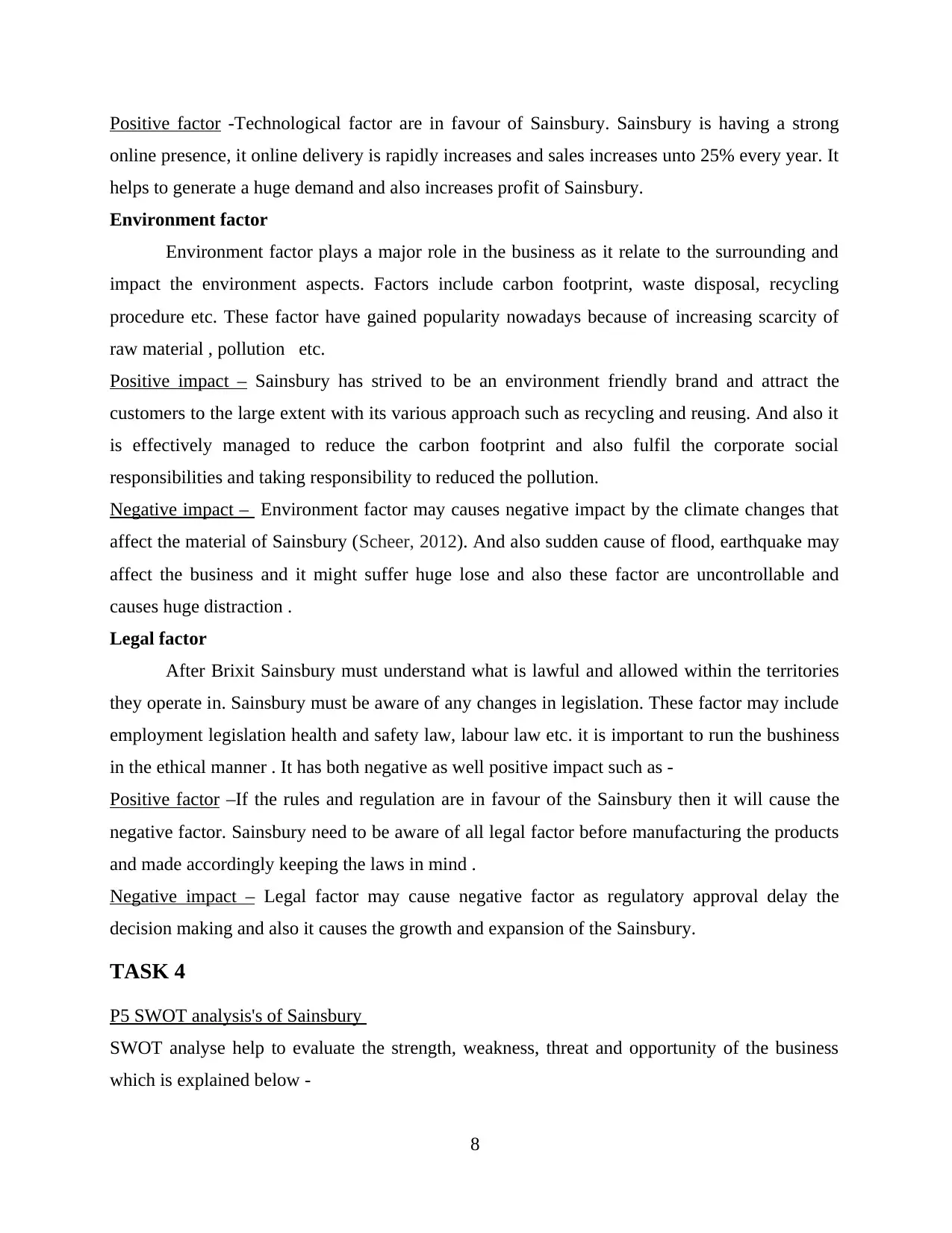
Positive factor -Technological factor are in favour of Sainsbury. Sainsbury is having a strong
online presence, it online delivery is rapidly increases and sales increases unto 25% every year. It
helps to generate a huge demand and also increases profit of Sainsbury.
Environment factor
Environment factor plays a major role in the business as it relate to the surrounding and
impact the environment aspects. Factors include carbon footprint, waste disposal, recycling
procedure etc. These factor have gained popularity nowadays because of increasing scarcity of
raw material , pollution etc.
Positive impact – Sainsbury has strived to be an environment friendly brand and attract the
customers to the large extent with its various approach such as recycling and reusing. And also it
is effectively managed to reduce the carbon footprint and also fulfil the corporate social
responsibilities and taking responsibility to reduced the pollution.
Negative impact – Environment factor may causes negative impact by the climate changes that
affect the material of Sainsbury (Scheer, 2012). And also sudden cause of flood, earthquake may
affect the business and it might suffer huge lose and also these factor are uncontrollable and
causes huge distraction .
Legal factor
After Brixit Sainsbury must understand what is lawful and allowed within the territories
they operate in. Sainsbury must be aware of any changes in legislation. These factor may include
employment legislation health and safety law, labour law etc. it is important to run the bushiness
in the ethical manner . It has both negative as well positive impact such as -
Positive factor –If the rules and regulation are in favour of the Sainsbury then it will cause the
negative factor. Sainsbury need to be aware of all legal factor before manufacturing the products
and made accordingly keeping the laws in mind .
Negative impact – Legal factor may cause negative factor as regulatory approval delay the
decision making and also it causes the growth and expansion of the Sainsbury.
TASK 4
P5 SWOT analysis's of Sainsbury
SWOT analyse help to evaluate the strength, weakness, threat and opportunity of the business
which is explained below -
8
online presence, it online delivery is rapidly increases and sales increases unto 25% every year. It
helps to generate a huge demand and also increases profit of Sainsbury.
Environment factor
Environment factor plays a major role in the business as it relate to the surrounding and
impact the environment aspects. Factors include carbon footprint, waste disposal, recycling
procedure etc. These factor have gained popularity nowadays because of increasing scarcity of
raw material , pollution etc.
Positive impact – Sainsbury has strived to be an environment friendly brand and attract the
customers to the large extent with its various approach such as recycling and reusing. And also it
is effectively managed to reduce the carbon footprint and also fulfil the corporate social
responsibilities and taking responsibility to reduced the pollution.
Negative impact – Environment factor may causes negative impact by the climate changes that
affect the material of Sainsbury (Scheer, 2012). And also sudden cause of flood, earthquake may
affect the business and it might suffer huge lose and also these factor are uncontrollable and
causes huge distraction .
Legal factor
After Brixit Sainsbury must understand what is lawful and allowed within the territories
they operate in. Sainsbury must be aware of any changes in legislation. These factor may include
employment legislation health and safety law, labour law etc. it is important to run the bushiness
in the ethical manner . It has both negative as well positive impact such as -
Positive factor –If the rules and regulation are in favour of the Sainsbury then it will cause the
negative factor. Sainsbury need to be aware of all legal factor before manufacturing the products
and made accordingly keeping the laws in mind .
Negative impact – Legal factor may cause negative factor as regulatory approval delay the
decision making and also it causes the growth and expansion of the Sainsbury.
TASK 4
P5 SWOT analysis's of Sainsbury
SWOT analyse help to evaluate the strength, weakness, threat and opportunity of the business
which is explained below -
8
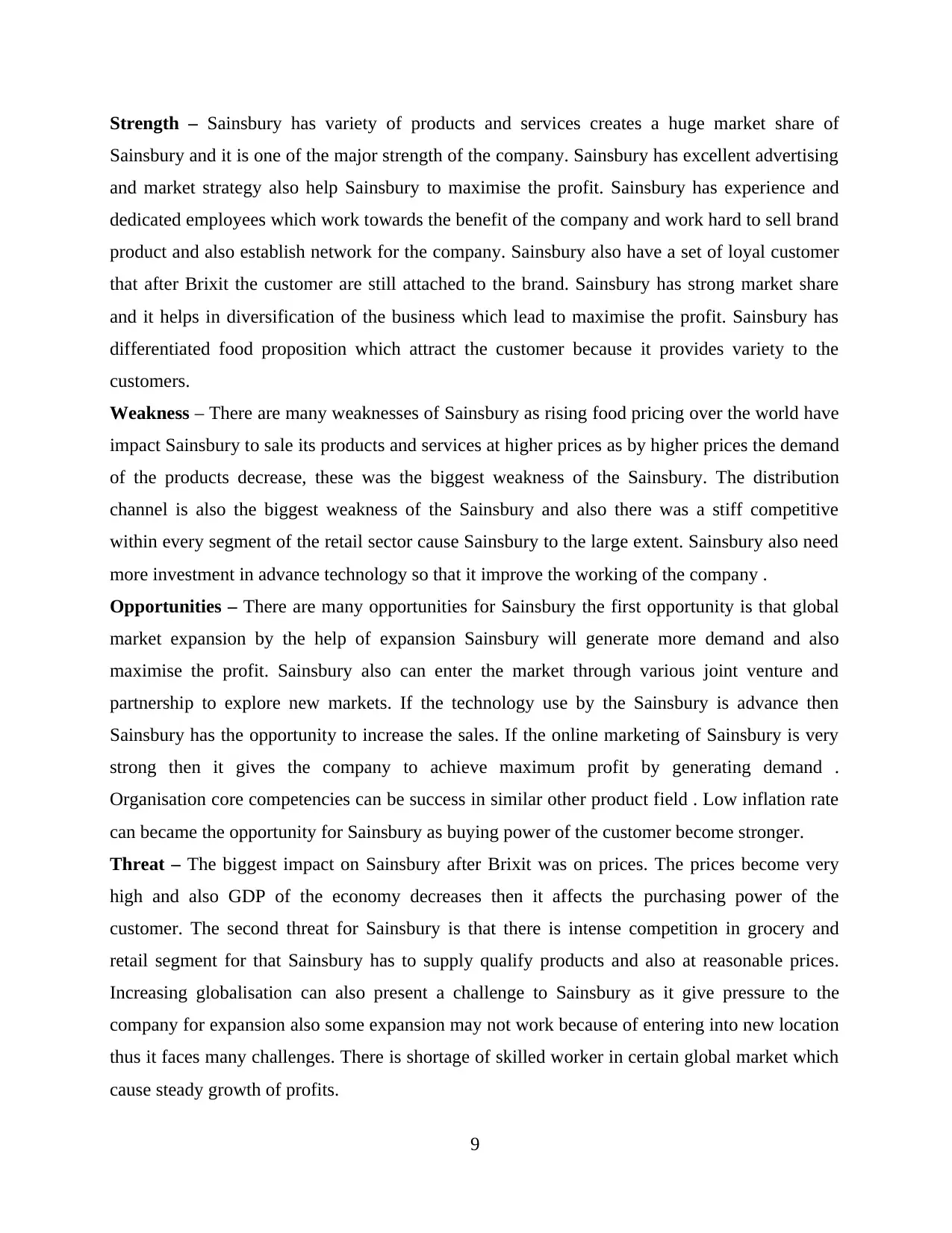
Strength – Sainsbury has variety of products and services creates a huge market share of
Sainsbury and it is one of the major strength of the company. Sainsbury has excellent advertising
and market strategy also help Sainsbury to maximise the profit. Sainsbury has experience and
dedicated employees which work towards the benefit of the company and work hard to sell brand
product and also establish network for the company. Sainsbury also have a set of loyal customer
that after Brixit the customer are still attached to the brand. Sainsbury has strong market share
and it helps in diversification of the business which lead to maximise the profit. Sainsbury has
differentiated food proposition which attract the customer because it provides variety to the
customers.
Weakness – There are many weaknesses of Sainsbury as rising food pricing over the world have
impact Sainsbury to sale its products and services at higher prices as by higher prices the demand
of the products decrease, these was the biggest weakness of the Sainsbury. The distribution
channel is also the biggest weakness of the Sainsbury and also there was a stiff competitive
within every segment of the retail sector cause Sainsbury to the large extent. Sainsbury also need
more investment in advance technology so that it improve the working of the company .
Opportunities – There are many opportunities for Sainsbury the first opportunity is that global
market expansion by the help of expansion Sainsbury will generate more demand and also
maximise the profit. Sainsbury also can enter the market through various joint venture and
partnership to explore new markets. If the technology use by the Sainsbury is advance then
Sainsbury has the opportunity to increase the sales. If the online marketing of Sainsbury is very
strong then it gives the company to achieve maximum profit by generating demand .
Organisation core competencies can be success in similar other product field . Low inflation rate
can became the opportunity for Sainsbury as buying power of the customer become stronger.
Threat – The biggest impact on Sainsbury after Brixit was on prices. The prices become very
high and also GDP of the economy decreases then it affects the purchasing power of the
customer. The second threat for Sainsbury is that there is intense competition in grocery and
retail segment for that Sainsbury has to supply qualify products and also at reasonable prices.
Increasing globalisation can also present a challenge to Sainsbury as it give pressure to the
company for expansion also some expansion may not work because of entering into new location
thus it faces many challenges. There is shortage of skilled worker in certain global market which
cause steady growth of profits.
9
Sainsbury and it is one of the major strength of the company. Sainsbury has excellent advertising
and market strategy also help Sainsbury to maximise the profit. Sainsbury has experience and
dedicated employees which work towards the benefit of the company and work hard to sell brand
product and also establish network for the company. Sainsbury also have a set of loyal customer
that after Brixit the customer are still attached to the brand. Sainsbury has strong market share
and it helps in diversification of the business which lead to maximise the profit. Sainsbury has
differentiated food proposition which attract the customer because it provides variety to the
customers.
Weakness – There are many weaknesses of Sainsbury as rising food pricing over the world have
impact Sainsbury to sale its products and services at higher prices as by higher prices the demand
of the products decrease, these was the biggest weakness of the Sainsbury. The distribution
channel is also the biggest weakness of the Sainsbury and also there was a stiff competitive
within every segment of the retail sector cause Sainsbury to the large extent. Sainsbury also need
more investment in advance technology so that it improve the working of the company .
Opportunities – There are many opportunities for Sainsbury the first opportunity is that global
market expansion by the help of expansion Sainsbury will generate more demand and also
maximise the profit. Sainsbury also can enter the market through various joint venture and
partnership to explore new markets. If the technology use by the Sainsbury is advance then
Sainsbury has the opportunity to increase the sales. If the online marketing of Sainsbury is very
strong then it gives the company to achieve maximum profit by generating demand .
Organisation core competencies can be success in similar other product field . Low inflation rate
can became the opportunity for Sainsbury as buying power of the customer become stronger.
Threat – The biggest impact on Sainsbury after Brixit was on prices. The prices become very
high and also GDP of the economy decreases then it affects the purchasing power of the
customer. The second threat for Sainsbury is that there is intense competition in grocery and
retail segment for that Sainsbury has to supply qualify products and also at reasonable prices.
Increasing globalisation can also present a challenge to Sainsbury as it give pressure to the
company for expansion also some expansion may not work because of entering into new location
thus it faces many challenges. There is shortage of skilled worker in certain global market which
cause steady growth of profits.
9
⊘ This is a preview!⊘
Do you want full access?
Subscribe today to unlock all pages.

Trusted by 1+ million students worldwide
1 out of 16
Related Documents
Your All-in-One AI-Powered Toolkit for Academic Success.
+13062052269
info@desklib.com
Available 24*7 on WhatsApp / Email
![[object Object]](/_next/static/media/star-bottom.7253800d.svg)
Unlock your academic potential
Copyright © 2020–2025 A2Z Services. All Rights Reserved. Developed and managed by ZUCOL.





